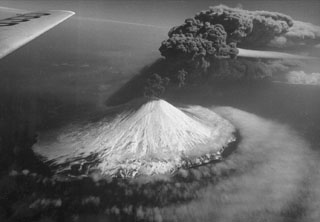Report on Alaid (Russia) — 14 September-20 September 2022
Smithsonian Institution / US Geological Survey
Weekly Volcanic Activity Report, 14 September-20 September 2022
Managing Editor: Sally Sennert.
Please cite this report as:
Global Volcanism Program, 2022. Report on Alaid (Russia) (Sennert, S, ed.). Weekly Volcanic Activity Report, 14 September-20 September 2022. Smithsonian Institution and US Geological Survey.
Alaid
Russia
50.861°N, 155.565°E; summit elev. 2285 m
All times are local (unless otherwise noted)
KVERT reported that an intense thermal anomaly over Alaid identified in satellite images beginning at 1139 on 15 September (local time) likely indicated the onset of a Strombolian eruption. The Aviation Color Code was raised to Yellow (the second lowest level on a four-color scale) the next day. Satellite images acquired at 1108 on 18 September showed a gas-and-steam plume containing ash drifting ESE. Several photographs of the eruption were taken that same day. The Aviation Color Code was raised to Orange.
Geological Summary. The highest and northernmost volcano of the Kuril Islands, Alaid is a symmetrical stratovolcano when viewed from the north, but has a 1.5-km-wide summit crater that is breached open to the south. This basaltic to basaltic-andesite volcano is the northernmost of a chain constructed west of the main Kuril archipelago. Numerous pyroclastic cones are present the lower flanks, particularly on the NW and SE sides, including an offshore cone formed during the 1933-34 eruption. Strong explosive eruptions have occurred from the summit crater beginning in the 18th century. Reports of eruptions in 1770, 1789, 1821, 1829, 1843, 1848, and 1858 were considered incorrect by Gorshkov (1970). Explosive eruptions in 1790 and 1981 were among the largest reported in the Kuril Islands.
Sources: Kamchatkan Volcanic Eruption Response Team (KVERT), Institute of Volcanology and Seismology (IVS) of the Far Eastern Branch of the Russian Academy of Sciences (FEB RAS)

